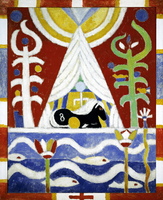Painting No. 4 (A Black Horse)
Hartley, Marsden

Download105172_cp.jpg (1.346Mb)
Date
1915Description
*
This painting was bequeathed to the Museum by Alfred Stieglitz, whose "291" gallery in New York was the focus of early modernism in the United States. It was Stieglitz who gave Marsden Hartley his first one-person show in 1909 and helped finance his trip to Europe in 1912. There Hartley came into contact with the works of Paul Cézanne, Pablo Picasso, and Henri Matisse as well as German Expressionists such as Wassily Kandinsky and Franz Marc. Hartley made Painting No. 4 while in Germany at the outbreak of World War I. A part of his "Amerika" series, it combines the bright colors, flattened space, and simplified forms of French and German modern painting with symbols loosely drawn from Native American culture. While conveying Hartley's interest in representing spiritual values, the symbolism--such as the horse in front of the tepee flanked by plant forms--intentionally resists precise interpretation. In the face of his immersion in European modernism, his use of Native American motifs underscored Hartley's own American identity. He also spoke of the Native Americans as a gentle race, a counterbalance to European cultures preparing for a world war. John B. Ravenal, from Philadelphia Museum of Art: Handbook of the Collections (1995), p. 311. full view
Type of Work
Oil paintingSubject
Religion, Tipis, Symbolism in art, Painting, American --20th century, Art, Modern --20th century, Horses in art, Native American arts
Rights
Rights Statement
Licensed for educational and research use by the MIT community only
Item is Part of
131296
